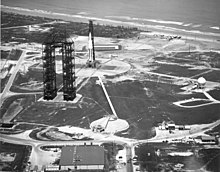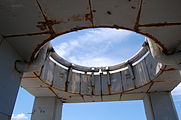
The John F. Kennedy Space Center, located in Merritt Island, Florida, is one of ten National Aeronautics and Space Administration field centers. Since December 1968, KSC has been NASA's primary launch center of human spaceflight. Launch operations for the Apollo, Skylab and Space Shuttle programs were carried out from Kennedy Space Center Launch Complex 39 and managed by KSC. Located on the east coast of Florida, KSC is adjacent to Cape Canaveral Air Force Station (CCAFS). The management of the two entities work very closely together, share resources, and even own facilities on each other's property.

Cape Canaveral Air Force Station (CCAFS) is an installation of the United States Space Force's 45th Space Wing.

SA-5 was the first launch of the Block II Saturn I rocket and was part of the Apollo program. In 1963, president John Kennedy identified this launch as the one which would place US lift capability ahead of the Soviets, after being behind for more than six years since Sputnik.

The Saturn IB was an American launch vehicle commissioned by the National Aeronautics and Space Administration (NASA) for the Apollo program. It replaced the S-IV second stage of the Saturn I with the much more powerful S-IVB, able to launch a partially fueled Apollo command and service module (CSM) or a fully fueled Apollo Lunar Module (LM) into low Earth orbit for early flight tests before the larger Saturn V needed for lunar flight was ready.

A service structure is a structure built on a rocket launch pad to facilitate assembly and servicing.

Launch Complex 39 (LC-39) is a rocket launch site at the John F. Kennedy Space Center on Merritt Island in Florida, United States. The site and its collection of facilities were originally built for the Apollo program and later modified for the Space Shuttle program.
A mobile launcher platform is a steel structure used to support a large multistage space vehicle which is assembled (stacked) vertically in a hangar, then transported to a launch pad. The MLP then becomes the support structure for launch. Alternatives to this method include horizontal assembly and transport to the pad, as used by Russia; and assembling the vehicle vertically on the launch pad, as the United States used for smaller launch vehicles.

The Kennedy Space Center Visitor Complex is the visitor center at NASA's Kennedy Space Center in Florida. It features exhibits and displays, historic spacecraft and memorabilia, shows, two IMAX theaters, and a range of bus tours of the spaceport. "Space Shuttle Atlantis" is home to the real Space Shuttle Atlantis orbiter and the Shuttle Launch Experience, a simulated ride into space. The center also provides astronaut training experiences, including a multi-axial chair and Mars Base simulator. The visitor complex also has daily presentations from a veteran NASA astronaut. A bus tour, included with admission, encompasses the separate Apollo/Saturn V Center. There were 1.7 million visitors to the visitor complex in 2016.

Cape Canaveral Air Force Station Space Launch Complex 37 (SLC-37), previously Launch Complex 37 (LC-37), is a launch complex on Cape Canaveral, Florida. Construction began in 1959 and the site was accepted by NASA to support the Saturn I program in 1963. The complex consists of two launch pads. LC-37A has never been used, but LC-37B launched uncrewed Saturn I flights and was modified and launched Saturn IB flights, including the first (uncrewed) test of the Apollo Lunar Module in space. It was deactivated in 1972. In 2001 it was modified as the launch site for Delta IV, a launch system operated by United Launch Alliance.

Launch Complex 14 (LC-14) is a launch site at Cape Canaveral Air Force Station in Florida. LC-14 was used for various manned and unmanned Atlas launches, including the Friendship 7 flight aboard which John Glenn became the first American to orbit the Earth.

Launch Complex 5 (LC-5) was a launch site at Cape Canaveral Air Force Station, Florida used for various Redstone and Jupiter launches.

Launch Complex 36 (LC-36)—formerly known as Space Launch Complex 36 (SLC-36) from 1997 to 2010—is a launch complex at Cape Canaveral Air Force Station in Brevard County, Florida. It was used for Atlas launches by NASA and the US Air Force from 1962 until 2005.
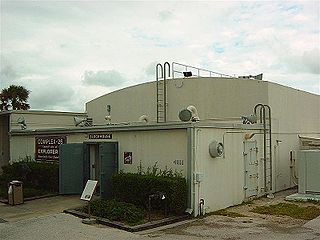
Launch Complex 26 (LC-26) is a deactivated launch site at Cape Canaveral Air Force Station, Florida. LC-26 consisted of two pads, A and B. Pad A was used for the Jupiter-C and Juno I rockets, and was the launch site for Explorer 1, the United States' first satellite, in 1958. Pad B was used for Juno II. Jupiter IRBMs were launched from both pads.
Launch Complex 6 (LC-6) at Cape Canaveral Air Force Station, Florida is a launch site used by Redstone and Jupiter series rockets and missiles. It is on the south end of Cape Canaveral, close to Launch Complex 5, with which it shared a blockhouse. With LC-5, it was the location of the first tests of the mobile launch concept designed by Kurt H. Debus. This concept was revised and improved and eventually used at LC-39 for the Saturn V and Space Shuttle.
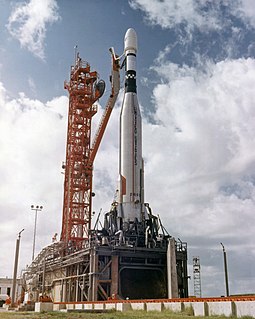
Launch Complex 13 (LC-13) was a launch complex at Cape Canaveral Air Force Station, the third-most southerly of the original launch complexes known as Missile Row, lying between LC-12 and LC-14. The LC-13 site is currently leased by SpaceX and has been renovated for use as Landing Zone 1 and Landing Zone 2, their east coast landing location for returning Falcon 9 and Falcon Heavy launch vehicle booster stages.

Mobile Launcher Platform 1 (MLP-1), formerly Mobile Launcher 3 (ML-3), is one of three Mobile Launcher Platforms used at Kennedy Space Center Launch Complex 39. Saturn V and Space Shuttle launches were conducted from MLP-1 between 1969 and 2009. It was modified for use in the Constellation program but ended up being used only once for the Ares I-X launch before the cancellation of the program.

Mobile Launcher Platform 3 or MLP-3, formerly Mobile Launcher 1 or ML-1 is one of three Mobile Launcher Platforms used at Kennedy Space Center Launch Complex 39. During the late 1960s and early 1970s, it was used for Saturn V and Saturn IB launches, and later for the Space Shuttle. It will be used to launch Northrop Grumman Innovation System's Omega rocket from LC-39B starting in 2021.

Launch Complex 31 (LC-31) is a former launch complex at Cape Canaveral Air Force Station, Florida.
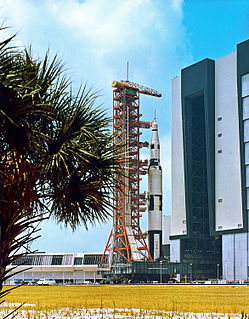
SA-500F was a dummy Saturn V used by NASA to test facilities at Launch Complex 39 at the Kennedy Space Center on Merritt Island, Florida throughout 1966. Tests included the mating of the Saturn's stages in the Vehicle Assembly Building (VAB), the fit of the service platforms, the launcher-transporter operation, the propellant loading system, and the test connections to the mobile launcher and support equipment.
